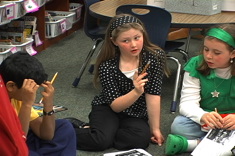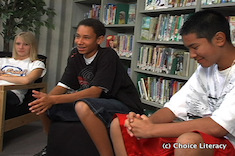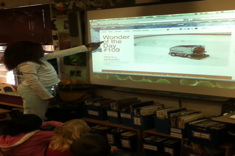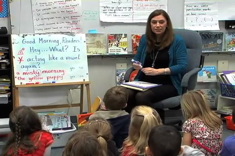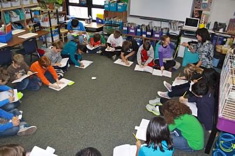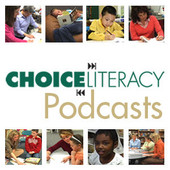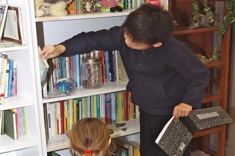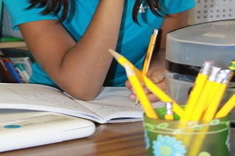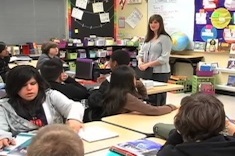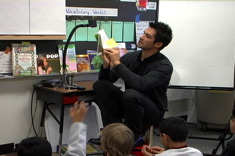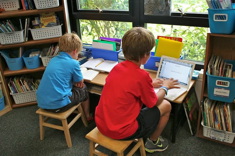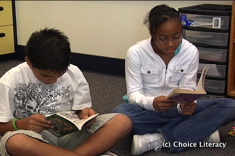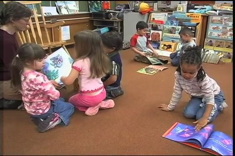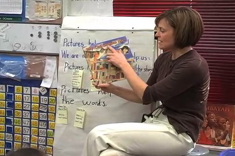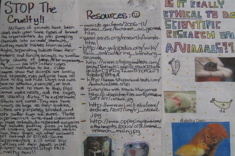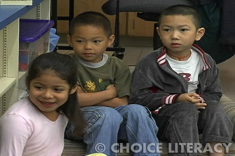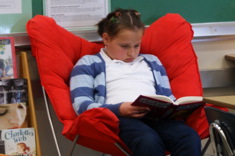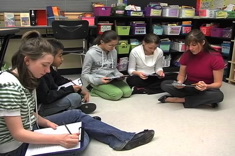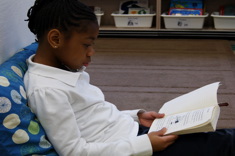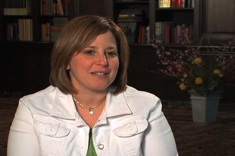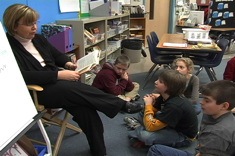Community Building
It's one of the big paradoxes of literacy instruction - students best learn how to read and write independently when they have a strong community of support in classrooms. How teachers build those thoughtful, kind, and challenging classroom communities is explained in these resources.
Latest Content
Off the Beaten Professional Development Path: What I Learned from the Teachers as Writers Group
Teacher writing groups are a wonderful informal way for teachers to get together over the summer voluntarily. Heather Rader has format suggestions, as well as tips for helping your group run smoothly.
A More Literate Show and Tell
Tammy Mulligan and Clare Landrigan work with a kindergarten teacher to integrate literacy skill development into this favorite routine of young children.
High School Students Take on a Reader’s Bill of Rights
Ellie Gilbert revisits the “rights of readers” with her high school students,revising the list based on their habits and preferences. The discussion leads to some surprising additions to the list of rights. This would be a fun activity to close out the school year, or to begin a summer program with children of almost any age.
Wonderopolis: Nonfiction, Technology, and Web-Based Independent Learning
Wonderopolis hits the sweet spot so many of us are looking for in web resources for students, delivering free, engaging, high-quality nonfiction text and video in small chunks that can easily be integrated into literacy and science workshops. Andrea Smith explains how she uses Wonderopolis daily with her students.
Ways to Collaborate With Your School Librarian
Teachers and school librarians would often love to collaborate more, but time is limited. After working for years as both a classroom teacher and school librarian, Franki Sibberson writes from experience as she shares practical suggestions for collaborating with school librarians.
Linking Morning Message, Poetry, and Word Learning
Second-grade teacher Linda Karamatic has been starting her morning with a message for years. The morning message is just one part of her daily opening that reinforces community.
More Literacy Keepsakes to Carry Home at the End of the School Year
Choice Literacy readers share more of their favorite end-of-year gifts for students to make and take home.
Preschool Morning Message
This five-minute video from Melissa Kolb's preschool classroom shows the value of morning message for teaching literacy skills. Melissa explains the skills children develop during this brief whole-class lesson and sharing time.
Beginning with the End in Mind: Planning Ahead for Closing Activities
Choice Literacy readers share their favorite end-of-year activities that circle back to events from the start of the school year.
Mary Lee Hahn – Read Alouds to Build Community Early in the Year (PODCAST)
Mary Lee Hahn shares her favorite read alouds for building community at the start of the year.
Keeping “House” in a Literacy-Rich Classroom
Ann Williams has a terrific idea for keeping materials organized in literacy workshops and building student independence at the same time.
Coaching Out of Chaos: Helping New Teachers Establish Management Systems
The #1 issue for many new teachers is management. Heather Rader shares how she tactfully assisted a novice teacher who needed help.
Pencil Plans
The care and use of the lowly pencil in classrooms says a lot about what we value and our relationships with students.
Who Rules?: Creating a Classroom Code of Conduct with Students
Heather Rader works with a young teacher to establish a better management system.
“I Am the One Who . . .” Building Writing Skills and Community in Middle Schools
In this 12-minute video, Katie Doherty leads her sixth-grade students as they try the prompt “I am the one who . . .” during writing workshop. This is an excellent activity for building classroom community.
Read Alouds for the First Day of School
Choice Literacy readers share their favorite read alouds for the start of the year.
Unexpected Gifts: Technology and Community in the First Days of School
Andrea Smith is surprised and delighted at what technology adds to her classroom in the early days of school.
Literacy Rights and Responsibilities
Something bad was happening in Katie Doherty’s middle school classroom—it was time to rebuild the class community with a reality check.
You Never Know What You’re Going To Get
When students help us organize materials, we are often pleasantly surprised at the results.
Preschool Book Browsing Time
This five-minute video from Kelly Petrin's preschool classroom shows the value of book browsing time. Kelly explains the skills children develop in language, book handling skills, and literacy independence during this time.
Primary Series Study
Katie DiCesare describes the primary series study unit she completes with her 1st and 2nd graders, combining reading, writing, and community building.
Persuasive Pamphlets
Erin Ocon and her middle-school students observe some political activists passing out pamphlets outside the building for a few moments. Voila – the pamphlet project is born. Pamphlets are the perfect genre for teaching persuasion and summary, two key skills highlighted in the Common Core.
Literacy Letters: Helping New Students Understand Ongoing Assignments
How do teachers bring new students up to speed with ongoing assignments? In this video from Katie Doherty’s middle school classroom, Katie presents the latest “Literary Letters” assignment to her 6th graders. It is early spring, and all but two of the students have experience with this writing assignment.
Getting to Know Multilingual Learners at the Start of the Year
If you’re unsure about working with multilingual learners, Stella Villalba has some reassuring advice for you.
Starting a Newbery Club with Students
If you want to re-energize teen and tween readers in your school, start a Newbery Club. These voluntary groups read, discuss, and take their best guess of which book will win the coveted award in mid-January.
“The Wrath of Guess Jeans”: Reading, Writing, and Cliques in Middle School
In this first video in a three-part series, Katie Doherty leads her 6th graders through a response activity. The text they are reading was written by a middle school student over a decade ago, and its themes of popularity and belonging still ring true for students.
Make it Personal
The connections we make with students and families are what we remember most when all is said and done. Trish Prentice has thoughts on what changes a respected teacher into a beloved teacher.
Launching the Newbery Club
Bill Prosser and Maria Caplin continue their series on a Newbery Club for 5gth graders in their school. In this installment, they write about the launch of the club.
Quick Takes: Advice on Book Hogs
In this quick take video, Franki Sibberson gives advice for dealing with "book hogs" — those students who try to grab any new book when it appears in the classroom library.
Reflections on a Year of Read Alouds
Karen Terlecky mulls over a year of read alouds in her 5th grade classroom as she makes plans for the coming year.
Browse Content By
Type
Category
- Assessment Tools
- Big Fresh Archives
- Booklists
- Choice Numeracy
- Classroom Design
- Common Core
- Community Building
- Conferring
- Content Literacy
- Digital Literacy
- English Language Learners
- Equity
- Family Relations
- Free Samples
- Guiding Groups
- Leadership
- Literacy Coaches
- Mentor Texts
- Minilessons
- New Teacher Mentors
- Podcasts
- Poetry
- Quote Collections
- Reading Strategies
- Self Care
- Struggling and Striving Learners
- Talking and Listening
- Teacher Study Groups
- Teaching Reading
- Teaching Writing
- Word Study and Vocabulary
Author
- Melissa Quimby
- Nawal Qarooni
- Gwen Blumberg
- Julie Cox
- The Lead Learners
- Hannah Tills
- Josie Stewart
- Ruth Metcalfe
- Mallory Messenger
- Becca Burk
- Jodie Bailey
- Vivian Chen
- Mary Brower
- Tiffany Abbott Fuller
- Stephanie Affinito
- Ruth Ayres
- Leigh Anne Eck
- Heather Fisher
- Shari Frost
- Julie Johnson
- Suzy Kaback
- Gigi McAllister
- Shirl McPhillips
- Melanie Meehan
- Cathy Mere
- Debbie Miller
- Tara Barnett and Kate Mills
- Tammy Mulligan
- Dana Murphy
- Bitsy Parks
- David Pittman
- Brenda Power
- Heather Rader
- Matt Renwick
- Mandy Robek
- Christy Rush-Levine
- Gretchen Schroeder
- Jen Schwanke
- Brian Sepe
- Katherine Sokolowski
- Stella Villalba
- Jennifer Vincent
Grade Level
Choice Literacy Membership
Articles
Get full access to all Choice Literacy article content
Videos
Get full access to all Choice Literacy video content
Courses
Access Choice Literacy course curriculum and training


